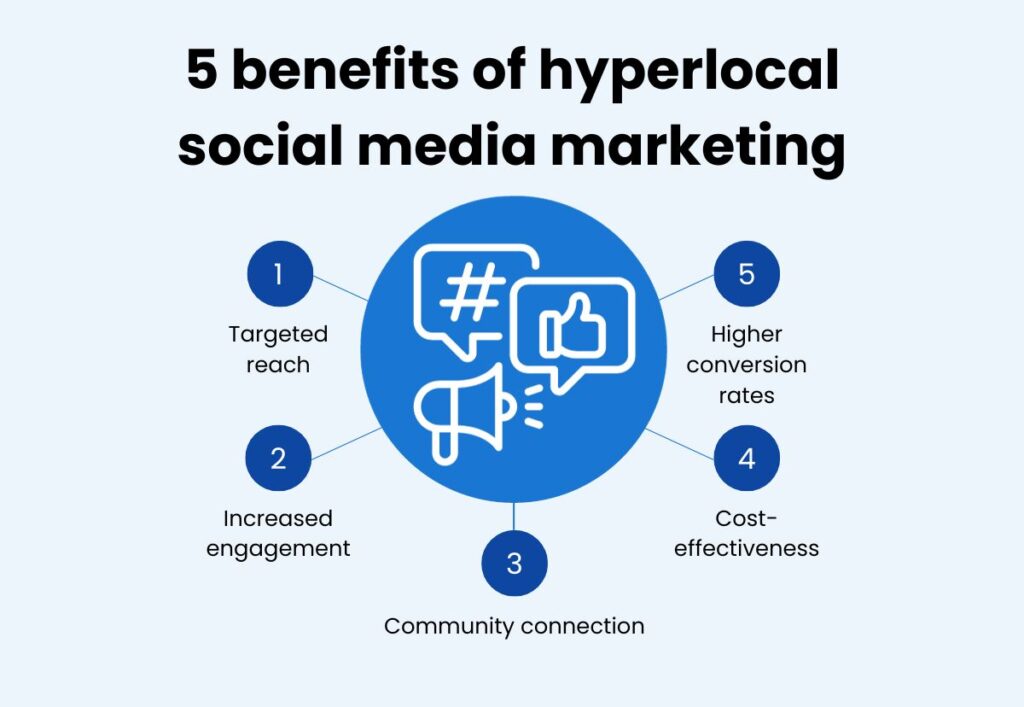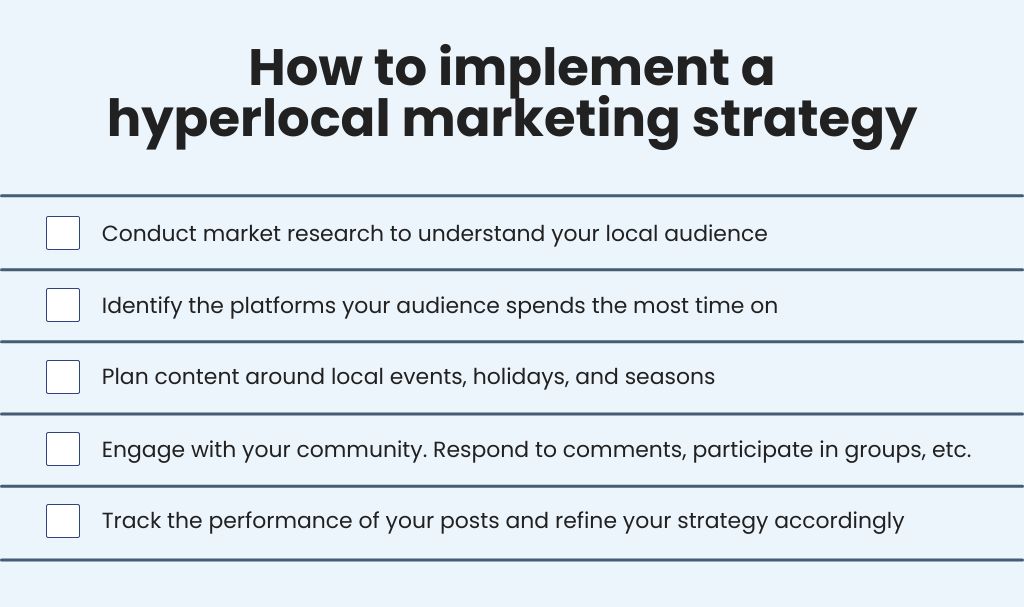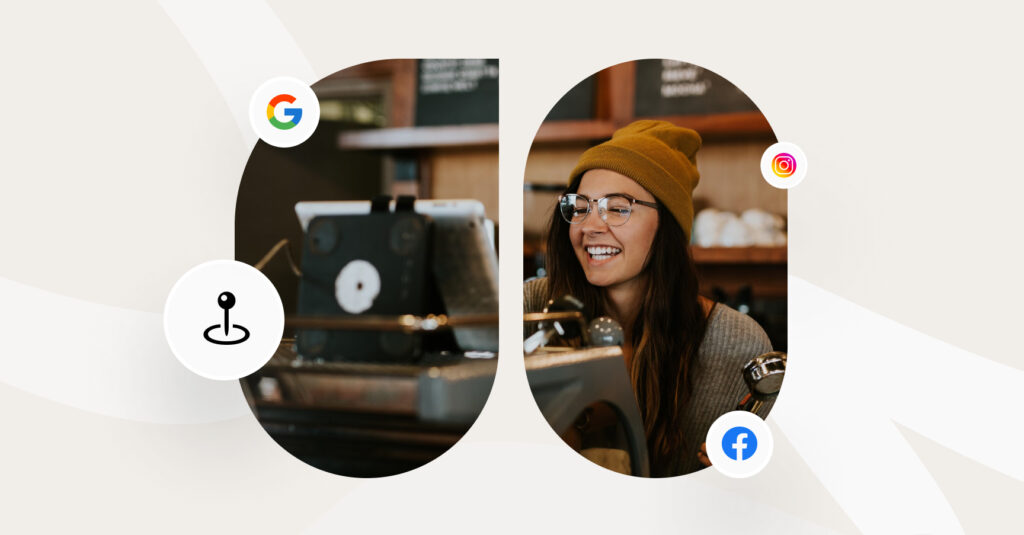While casting a wide marketing net might be tempting, often, the magic happens when targeting is razor-sharp. Knowing your customers on a personal level isn’t just a perk of running a local business; it’s your superpower.
Hyperlocal social media marketing allows you to harness this power, turning every digital interaction into a meaningful engagement. It’s not about reaching the masses; it’s about connecting deeply with those who walk the streets of your neighborhood. In other words, hyperlocal social media marketing ensures that your message resonates with the people who are most likely to visit your store, use your services, or engage with your brand.
In this blog, you’ll learn what hyperlocal social media marketing is, why it’s so beneficial, and how to craft a hyperlocal social marketing strategy.
Table of contents
- What is hyperlocal social media marketing?
- Why hyperlocal targeting matters for local businesses
- Effective strategies for hyperlocal social media marketing
- Common hyperlocal marketing challenges and how to overcome them
- How to implement a hyperlocal marketing strategy: 5 steps
- Hyperlocal social media marketing FAQs
- Master hyperlocal social media marketing with Birdeye Social
What is hyperlocal social media marketing?
Hyperlocal social media marketing, or hyperlocal advertising, is a strategy that zeroes in on a narrowly defined audience within a local area. This form of marketing tailors content, promotions, and engagement to fit a local community’s unique interests, needs, and cultural nuances.
Hyperlocal vs. traditional social media marketing
While traditional social media marketing employs a broad approach, hyperlocal social marketing narrows the focus. It’s the difference between advertising to an entire city, state, or country versus focusing on a single neighborhood. A few ways these two strategies differ are highlighted in the table below.
| Traditional | Hyperlocal | |
| Audience | Broad, often aiming at a regional, national, or global audience | Hyperlocal targeting is aimed at specific neighborhoods or small, localized groups |
| Content relevance | Generalized content that appeals to various interests and needs | Tailored content that resonates with local trends, events, and community-specific interests |
| Marketing goals | Typically focuses on brand awareness on a large scale and reaching new markets | Aims to build a solid local presence, drive local traffic, and develop loyal customer bases |
| ROI Measurement | Broader metrics like overall reach, brand sentiment, and global engagement rates | More focused metrics like local engagement rates, foot traffic, and community impact |
Why hyperlocal targeting matters for local businesses
For local businesses, hyperlocal targeting isn’t just an option; it’s a necessity. According to a Birdeye poll, 57% of users turn to social media to search for local businesses, which means standing out in your immediate geographic area is crucial.
5 benefits of hyperlocal social media marketing for local businesses

1. Targeted reach
Hyperlocal targeting helps you get in front of a local audience that is genuinely interested in your services. This means crafting messages that reflect local events, cultural nuances, or even local dialects, making your content deeply relatable and significantly increasing the likelihood of engagement and conversion.
2. Increased local engagement
When your content resonates with the local community, it drives higher interaction. By showcasing local landmarks, participating in local events, or highlighting customer stories within the community, you foster engagement and build a sense of belonging among your audience.
3. Cost-effectiveness
Focusing your resources on a specific geographical area allows for a more strategic marketing budget allocation. This approach reduces the waste of resources on uninterested demographics and enhances ROI by targeting users with a higher propensity to respond to your local offerings.
4. Community connection
By focusing on hyperlocal strategies, your business becomes a recognizable part of the local landscape. Engaging in community projects, supporting local causes, or partnering with other local businesses can embed your brand into the community’s fabric, fostering loyalty and trust.
5. Higher conversion rates
Tailoring your content and promotions to the local audience’s needs and interests leads to more resonant offerings and compelling calls to action. For example, offering promotions during local festivals or events or exclusive discounts for local residents creates compelling reasons for your audience to engage with your brand.
Make Hyperlocal Social Media Management a Breeze
Want to see the impact of Birdeye on your business? Watch the Free Demo Now.
Effective strategies for hyperlocal social media marketing
1. Leverage local events and trends
Share stories, images, and videos that reflect local lifestyles, landmarks, and interests. This might include a ‘day in the life’ of a local personality, stories about the history of your locality, or showcases of local events. The key is to create content that resonates with the local community’s identity and experiences.
2. Use geo-targeting features
Platforms like Facebook and Instagram offer features that allow you to direct your content to specific geographic locations. This can be as broad as a city or as narrow as a zip code. Utilizing these features ensures that your content reaches the eyes of those most relevant to your business.
3. Create locally relevant content
Share stories, images, and videos that reflect the local lifestyle, landmarks, and interests. This might include a ‘day in the life’ of a local personality, stories about the history of your town, or showcases of local events. The key is to create content that resonates with the local community’s identity and experiences.
4. Engage with local influencers
Collaborating with local influencers can amplify your reach significantly. These influencers could include local celebrities, prominent business figures, or well-known social media personalities. Their endorsement can lend credibility and dramatically boost your visibility in the local area.
5. Monitor local hashtags and trends
Participate in conversations around local hashtags, respond to local issues, and engage with local influencers and businesses. This increases your visibility and shows that you’re an active and aware local community member. You can even create original hashtags to promote local pride and encourage user-generated content. For example, a hometown pizzeria can tag #BestChicagoPizza, or a boutique can create #ShopLocalOakville.
Fresh out of social media content ideas? Let AI do the work. Generate engaging posts that are tailored to your customers in just a few clicks with Birdeye’s social media management software.
6. Optimize your profile information
Ensure your profile and bio clearly state your location or local service area. List the city, neighborhood, and other regional details. Have a local address prominently in the business name field. This will help people find you in local searches.
Common hyperlocal marketing challenges and how to overcome them

Challenge #1: You lack marketing expertise
Just because you’re an expert in your industry doesn’t mean you’re an expert marketer — but don’t let this stop you from experimenting with marketing trends and strategies. Leverage online resources, workshops, and community business groups to enhance your knowledge. Platforms like Coursera or LinkedIn Learning offer courses in social media, hyperlocal marketing, and more.
Challenge #2: You lack the proper tools
To maximize your hyperlocal social media presence, you need the right tools. Birdeye Social makes creating and publishing location-specific content that caters to a hyperlocal audience easy. Additionally, the platform provides actionable insights and location-specific analytics, enabling you to understand and respond to your hyperlocal audiences’ unique preferences and trends.
Challenge #3: You haven’t narrowed down your audience
Hyperlocal social marketing only works if you know your audience like the back of your hand. Avoid scattershot posting to generic groups. Get granular with demographics, interests, values, hang-out spots, and niche communities. This allows you to craft content and partnerships tailored to resonate locally.
How to implement a hyperlocal marketing strategy: 5 steps

- Identify your local audience: Conduct market research to understand your local audience’s demographics, interests, and behaviors. Tools like Facebook Insights can provide valuable data about the people engaging with your page.
- Choose the right platforms: Not all social media platforms are equally effective for every audience. For example, platforms like Instagram or TikTok might be more effective if your target audience is younger. For an older demographic, Facebook or LinkedIn could be more appropriate.
- Create a content calendar: Plan content around local events, holidays, and seasons. For instance, if you run a local cafe, you might create posts about special menu items during local festivals or events.
- Engage actively with your community: Engagement goes beyond posting content. Respond to comments, participate in local social media groups, and collaborate with other local businesses for cross-promotion. This increases your visibility and positions your business as an active community member.
- Measure and adjust your strategy: Use analytics tools to track the performance of your posts. Look for patterns in what types of content get the most engagement and at what times your audience is most active. Use these insights to refine your content strategy.
Hyperlocal social media marketing FAQs
An example of hyperlocal targeting is a local coffee shop using geofencing technology to send promotional notifications to smartphone users who enter a specific area, such as a nearby office building or residential block. This approach allows businesses to target potential customers within an exact geographic location, offering them deals or information relevant to their proximity to the store.
Hyperlocal social marketing refers to tailoring social media marketing campaigns to a specific geographical area or community. This strategy involves creating highly relevant organic content and advertisements for local audiences, focusing on their unique characteristics, interests, and needs. It often includes engaging with local events, trends, and community discussions on social media platforms to connect more intimately with the local customer base.
– Limited reach, as it targets a small, specific area, potentially reducing the overall audience size.
– Can also involve higher costs and effort in creating numerous localized campaigns versus broader campaigns.
– Requires in-depth knowledge of local markets, which can be challenging for businesses without local presence or insights.
– Risk of alienating broader but relevant audiences.
Master hyperlocal social media marketing with Birdeye Social
With Birdeye Social, creating and publishing location-specific content is easy. Its AI-powered platform offers features like bulk scheduling and AI-generated content, allowing for efficient management of multiple social media accounts across different locations.
Ready to take your hyperlocal social media marketing efforts to the next level? Watch a demo today to learn more.

Originally published



